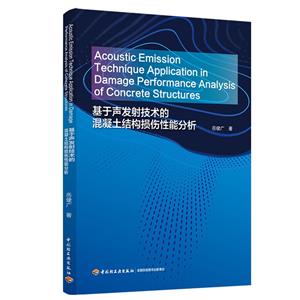基于声发射技术的混凝土结构损伤性能分析(英文) 版权信息
- ISBN:9787518433100
- 条形码:9787518433100 ; 978-7-5184-3310-0
- 装帧:一般胶版纸
- 册数:暂无
- 重量:暂无
- 所属分类:>>
基于声发射技术的混凝土结构损伤性能分析(英文) 本书特色
为作者近年结合声发射检测技术在混凝土微观开裂模式、本构关系、构件损伤性能方面的研究成果。
基于声发射技术的混凝土结构损伤性能分析(英文) 内容简介
本书介绍了声发射测试技术基本原理,论述了作者近年结合该技术在混凝土微观开裂模式、本构关系、构件损伤性能方面的研究成果。将声发射测试技术与损伤及断裂力学相结合,开展了系列试验及理论研究,建立了普通混凝土及钢纤维混凝土的单 轴受拉损伤本构模型、混凝土构件损伤性能水准和损伤评估模型。 本书可供土木工程、水利工程、交通工程、岩土工程、工程力学等领域的工程师、科学技术人员与高等院校师生参考。
基于声发射技术的混凝土结构损伤性能分析(英文) 目录
第1章 绪论
1.1 声发射监测技术
1.2 声发射参数
1.3 声发射传感器
第2章 基于声发射的微裂缝开裂模式判别方法
2.1 基本原理
2.2 经验方法
2.3 机器学习方法
2.3.1 基于声发射的数据集
2.3.2 无标签数据的聚类算法
2.3.3 数据聚类的超平面算法
参考文献
第3章 混凝土单轴受拉损伤力学行为
3.1 前言
3.1.1 断裂力学方法
3.1.2 损伤力学方法
3.2 考虑断裂过程区特性的损伤演化方程
3.2.1 断裂过程区内的应力分布
3.2.2 损伤演化方程
3.3 试验方法
3.3.1 材料性能
3.3.2 加载与测试方案
3.4 断裂力学性能
3.5 声发射特性
3.5.1 声发射撞击率
3.5.2 声发射计数
3.5.3 声发射峰频
3.5.4 声发射幅值
3.5.5 声发射能量
3.6 基于声发射的损伤演化方程
3.6.1 损伤与应变演化之间的关系
3.6.2 模型对比
3.7 结论
参考文献
第4章 钢纤维混凝土单轴受拉损伤力学行为
4.1 前言
4.2 钢纤维混凝土受拉力学机制
4.2.1 纤维-基体耦合机制
4.2.2 塑性损伤本构模型
4.3 试验方法
4.3.1 材料性能
4.3.2 加载与测试方案
4.4 断裂过程
4.5 纤维影响分析
4.6 微裂缝开裂判别
4.7 基于声发射的损伤演化方程
4.7.1 损伤因子的拟合表达式
4.7.2 应力-应变曲线对比
4.7.3 P-CMOD曲线对比
4.8 结论
参考文献
第5章 低周反复作用下RC柱的损伤力学性能
5.1 前言
5.2 试验方法
5.2.1 试验模型与声发射监测
5.2.2 加载制度
5.3 破坏过程
5.4 声发射特性
5.5 声发射能量与滞回耗能之间的关系
5.6 基于声发射的损伤评估模型
5.7 结论
参考文献
第6章 弯曲型RC框架梁-柱边节点损伤力学性能
6.1 前言
6.2 试验方法
6.2.1 加载方案
6.2.2 声发射监测
6.3 破坏过程
6.4 基于声发射的损伤性能水准
6.5 损伤临界状态判别准则分析
6.6 数值模拟
6.6.1 有限单元
6.6.2 材料本构模型
6.6.3 模型标定
6.7 损伤性能水准的量化
6.7.1 损伤评估模型
6.7.2基于概率统计的临界状态损伤值
6.8 结论
参考文献
第7章 低周反复作用下型钢混凝土柱的损伤力学性能
7.1 前言
7.2 试验方法与结果
7.2.1 试件破坏结果
7.2.2 截面应变分析
7.2.3 基于声发射的性能水准
7.3 临界状态应变分析
7.3.1 纵筋屈曲
7.3.2 型钢翼缘屈服
7.3.3 型钢翼缘局部屈曲
7.4 数值模拟
7.4.1 材料本构模型
7.4.2 模型标定
7.5 损伤性能水准的量化
7.5.1 损伤评估模型
7.5.2 基于概率统计的临界状态损伤值
7.6 结论
参考文献
第8章 轴压作用下方钢管混凝土柱损伤演化与声发射特性
8.1 前言
8.2 试验方法
8.3 破坏过程
8.4 声发射特性
8.5 声发射能量与波的强度
8.6 损伤演化及钢管屈曲
8.7 结论
参考文献
基于声发射技术的混凝土结构损伤性能分析(英文) 节选
Chapter 1 Introduction 1.1 Acoustic emission monitoring technique To detect the damage of materials (i.e. metals, ceramics, composites, rocks and concrete) in members or structures, some non-destructive techniques, e.g. the laser speckle technique [1], the ultrasonic probing technique [2], the X-ray CT method [3] and the Acoustic Emission (AE) technique [4], have been widely used in Civil Engineering. Among these monitoring methods, the AE technique is a very powerful way to monitor the strain energy release due to propagation of stress waves caused by micro-cracking inside the material [5] for at least a century. In 1920, Abram Joffe observed the noise generated by deformation process of Salt and Zinc crystals. In 1948, Warren P. Mason and H. J. McSkimin et al. suggested measuring AE to observe the moving dislocations by means of the stress waves. In 1950, Josef Kaiser used tensile tests to determine the characteristics of AE in engineering materials. In 1969, Dunegan founded the first company that specializes in the production of AE equipment. Acoustic Emission (AE) technique captures the elastic stress waves coming from material damage sources, such as the micro-crack initiation and propagation, crushing, interface friction, fiber breaking etc., then converts them into electrical signals with the aid of piezoelectric transducers placed on the surface of the members or structures. Acoustic Emission can be defined as a transient elastic wave generated by the rapid release of energy within a material. As shown in Fig. 1-1, an electric circuit of AE measurement consists of a sensor, a preamplifier, a filter, a main amplifier, a cable and a detector. The AE event is a single dynamic process releasing elastic energy. The local process producing AE event is called the AE source. The electrical signal detected at the output pf the transducer is termed the AE signal. AE technique can be used to the member or structure which is under normal, service conditions or during loading over a long time. For the frequencies range of commonly used for AE monitoring, the AE sensors can detect the signal for surface movements of or less, a thousand times smaller than the size of an atom. Wave motions are defined on the basis of orientations of particles motions and directions of propagations. Being similar to the earthquake motions, AE waves consist the following waves (Fig. 1-2): (1) Longitudinal wave (Primary wave). It propagates through all media and is the fastest of elastic waves. In this case, particles vibrate along the direction in which the wave propagates. (2) Transverse wave (Secondary wave). It can propagate through solids but not through liquids and gases. In this case, particles vibrate perpendicular to the direction in which the wave propagates. (3) Other waves. Longitudinal and transverse waves are always generated and propagate in solid. While, other waves, i.e. surface and plate waves are generalized in solid following the longitudinal and transverse waves arriving at the surface.
基于声发射技术的混凝土结构损伤性能分析(英文) 作者简介
岳健广,同济大学博士,美国加州大学戴维斯分校访问学者,现为南京工业大学副教授、硕士生导师,主要从事土木工程结构多尺度损伤性能分析及设计理论、钢—混凝土组合结构、水泥基类材料本构关系、断裂与损伤力学方面的研究工作。曾主持国家自然科学基金2项、江苏省自然科学基金2项、中国博士后科学基金1项、江苏省高等教育教改研究重点课题1项。发表论文30余篇、授权专利5项、主编教材1部。
- >
小考拉的故事-套装共3册
小考拉的故事-套装共3册
¥36.7¥68.0 - >
诗经-先民的歌唱
诗经-先民的歌唱
¥13.5¥39.8 - >
史学评论
史学评论
¥23.2¥42.0 - >
随园食单
随园食单
¥15.4¥48.0 - >
月亮虎
月亮虎
¥14.4¥48.0 - >
新文学天穹两巨星--鲁迅与胡适/红烛学术丛书(红烛学术丛书)
新文学天穹两巨星--鲁迅与胡适/红烛学术丛书(红烛学术丛书)
¥9.9¥23.0 - >
二体千字文
二体千字文
¥14.0¥40.0 - >
月亮与六便士
月亮与六便士
¥18.1¥42.0
-
结构风荷载理论与Matlab计算
¥28.6¥55 -
4.23文创礼盒A款--“作家言我精神状态”
¥42.3¥206 -
4.23文创礼盒B款--“作家言我精神状态”
¥42.3¥206 -
一句顶一万句 (印签版)
¥40.4¥68 -
百年书评史散论
¥14.9¥38 -
1980年代:小说六记
¥52.8¥69




















